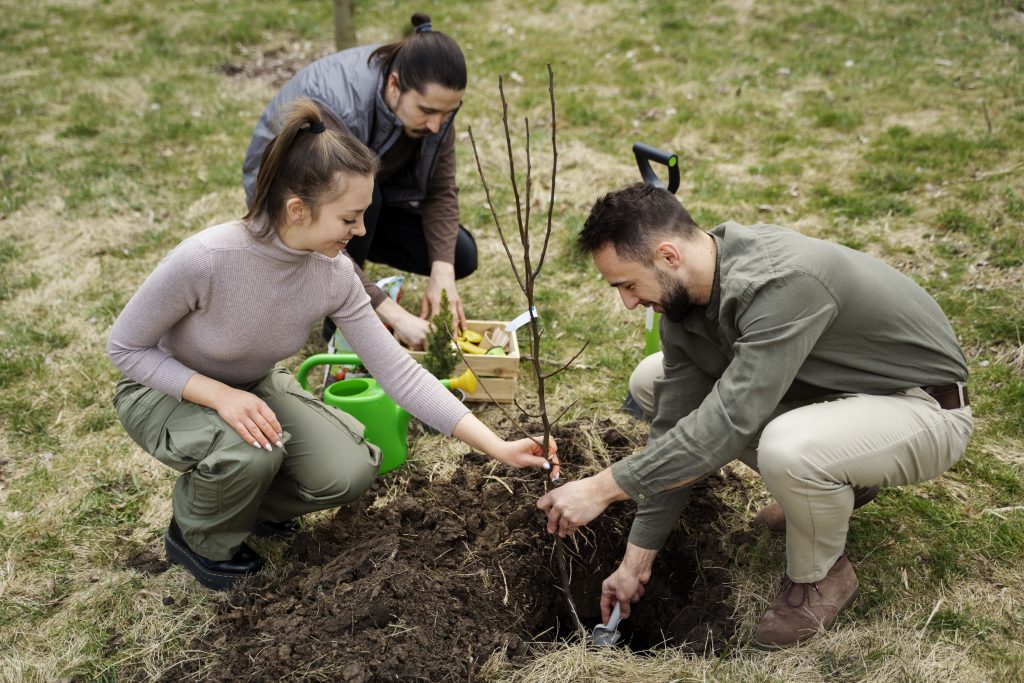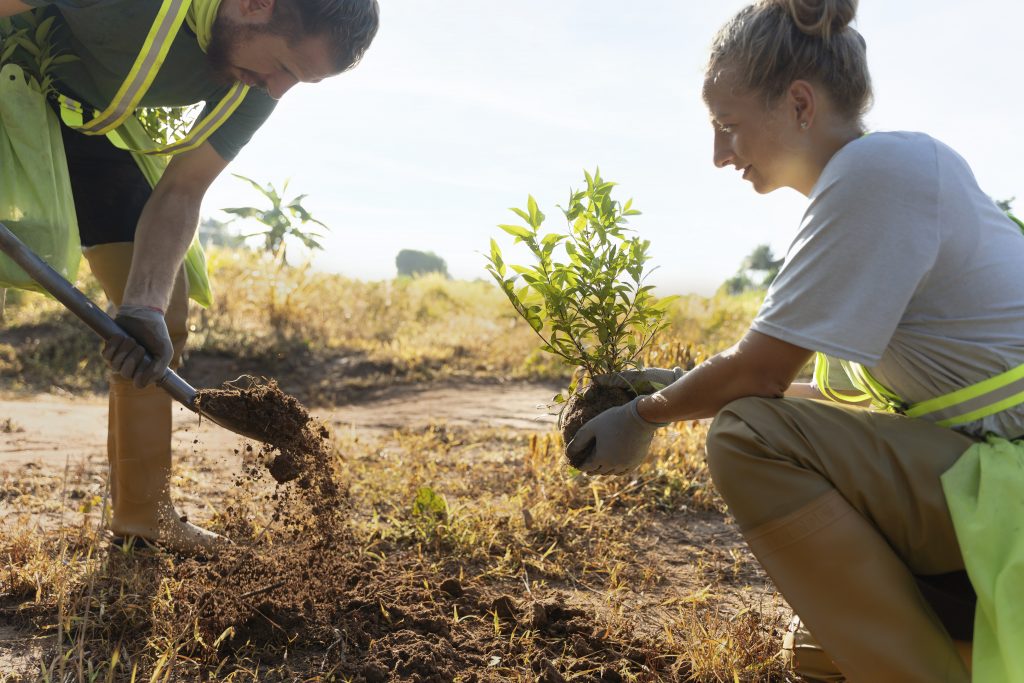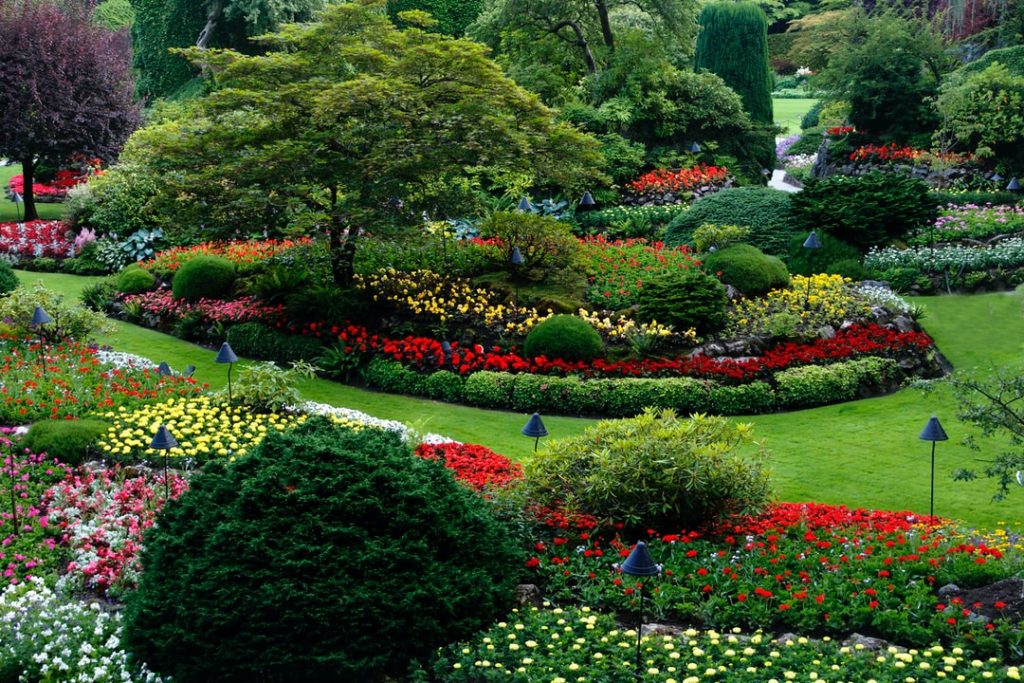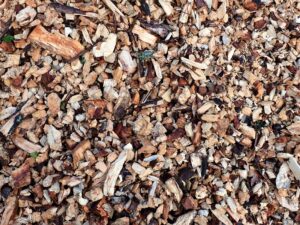Common Mistakes to Avoid During Tree Planting
COMMON MISTAKES TO AVOID DURING TREE PLANTING
Tree planting holds significant importance for both environmental and community benefits, making it a crucial practice for sustainable urban and rural development. Here’s an overview of the key reasons why tree planting is essential:
Environmental Benefits:

• Air Quality Improvement: Trees absorb carbon dioxide (CO2) during photosynthesis and release oxygen (O2), helping to mitigate air pollution and enhance air quality. They also filter out pollutants, such as particulate matter and harmful gases, from the atmosphere.
• Climate Change Mitigation: Trees sequester carbon, acting as carbon sinks. By removing CO2 from the atmosphere, they play a vital role in combating climate change and reducing the greenhouse effect.
• Temperature Regulation: Trees provide shade and reduce surface temperatures through a process called transpiration, where they release water vapor. This cooling effect helps combat the urban heat island effect, making cities more livable and energy-efficient.
• Soil Conservation: Tree roots stabilize soil, preventing erosion and landslides. They also improve soil structure and fertility by adding organic matter through leaf litter and root decomposition.
• Biodiversity Support: Trees provide habitat, food, and shelter for a wide variety of wildlife, including birds, insects, and mammals. Urban green spaces with trees can serve as important wildlife corridors and refuges.
• Water Management: Trees help regulate water flow by absorbing rainwater and reducing runoff. This aids in flood prevention and groundwater recharge, contributing to overall water resource management.
Community Benefits:
• Enhanced Aesthetics: Trees beautify urban and rural landscapes, making them more visually appealing. Well-planned tree planting projects can improve the overall quality of public spaces.
• Improved Mental Health: Exposure to green spaces and nature, including trees, has been linked to reduced stress, anxiety, and improved mental well-being. Trees provide a sense of tranquility and connection with the natural world.
• Economic Value: Trees increase property values in residential areas, making neighborhoods more desirable places to live. They also attract businesses and tourists to urban areas, stimulating local economies.
• Social Cohesion: Tree planting initiatives often involve community participation, fostering a sense of ownership and pride among residents. Green spaces with trees can serve as gathering places for social activities.
• Health Benefits: Trees contribute to better public health by reducing air pollution, providing shade for outdoor activities, and encouraging physical exercise through parks and green spaces.
• Energy Savings: Strategically planted trees around homes and buildings can provide shade in the summer and windbreak in the winter, reducing energy consumption for heating and cooling.
• Noise Reduction: Trees can act as natural sound barriers, mitigating noise pollution from roads and urban activities, creating quieter and more peaceful environments.
• Educational Opportunities: Tree planting projects offer educational opportunities for schools and communities, raising awareness about environmental conservation and the importance of tree care.
Tree planting is a multifaceted practice that has far-reaching benefits for the environment, public health, and community well-being. It contributes to a sustainable and resilient future, where people and nature coexist harmoniously. Therefore, promoting tree planting initiatives and responsible tree care practices is essential for building greener, healthier, and more vibrant communities.
The Significance Of Proper Tree Planting Techniques

Proper tree planting techniques are of paramount significance because they ensure the successful establishment and long-term health of trees. When trees are planted correctly, they are more likely to thrive, provide their intended benefits, and contribute positively to the environment and community. Here’s why proper tree planting techniques are crucial:
• Survival and Growth: Proper planting techniques increase the likelihood of a tree’s survival and healthy growth. Trees face stress during transplanting, and following correct procedures minimizes this stress, allowing them to establish themselves more effectively.
• Root Development: Proper planting includes attention to root health, spacing, and depth. Healthy root development is critical for the tree’s ability to absorb water and nutrients, anchor itself securely, and resist environmental stresses.
• Disease and Pest Resistance: Trees planted correctly are less susceptible to diseases and pests. Proper spacing and placement can reduce crowding, which can make trees more vulnerable to infestations and infections.
• Reduced Maintenance: Well-planted trees often require less maintenance over time. They are more likely to have strong, well-balanced structures that need fewer corrective pruning interventions.
• Environmental Benefits: Properly planted trees provide maximum environmental benefits, such as carbon sequestration, air and water purification, and temperature regulation. Healthy trees are more efficient in performing these ecosystem services.
• Aesthetic Value: Properly planted trees enhance the visual appeal of landscapes, streetscapes, and urban areas. They contribute to the aesthetics of the environment, increasing property values and community pride.
• Community Engagement: Tree planting projects often involve community participation and awareness-building. Proper techniques ensure that community efforts result in successful tree establishment and long-term benefits.
• Cost Savings: Correct planting techniques can save money in the long run by reducing the need for tree replacements, additional care, and potential hazards associated with poorly planted trees.
• Ecosystem Support: Trees that are planted properly are more likely to support biodiversity by providing habitat and food for wildlife. They can also enhance soil health and water retention in the ecosystem.
• Urban Benefits: In urban areas, proper tree planting can reduce the urban heat island effect, mitigate noise pollution, and provide shade, improving overall urban living conditions.
• Safety: Trees planted according to proper techniques are less likely to pose safety hazards from falling branches or unstable growth patterns. This enhances public safety and reduces liability risks.
• Longevity: Properly planted trees often have longer lifespans, ensuring that their environmental and community benefits are sustained over time.
• Educational Opportunities: Teaching and demonstrating proper tree planting techniques can raise awareness about the importance of trees and foster a sense of environmental stewardship in communities.
Proper tree planting techniques are essential for maximizing the ecological, economic, and social benefits that trees offer. Investing time and effort in learning and implementing these techniques ensures that newly planted trees have the best chance of thriving and making a positive impact on the environment and society for generations to come.
Common Mistakes And Their Potential Consequences
Common mistakes in tree planting can have significant consequences for the health and vitality of trees, as well as for the environment and the community. Understanding these mistakes and their potential repercussions is essential for promoting successful tree planting initiatives. Here’s an overview of common mistakes and their consequences:
Wrong Tree Species Selection:
• Consequence: Choosing a tree species ill-suited to the local climate and soil conditions can result in poor growth, susceptibility to diseases and pests, and premature tree death.
Inadequate Site Preparation:
• Consequence: Failing to properly prepare the planting site by addressing soil compaction, drainage issues, and competing vegetation can impede root development, leading to stunted growth and reduced tree lifespan.
Improper Planting Hole:
• Consequence: Digging a hole that is too deep or too narrow can suffocate the roots, hinder establishment, and result in root girdling, where roots grow in a circular pattern around the root ball.
Ignoring Root Health:
• Consequence: Neglecting to inspect and address root defects, such as circling roots, can lead to long-term structural issues, reduced stability, and potential tree failure.
Planting Depth Errors:
• Consequence: Planting a tree too deep or too shallow can lead to poor root-to-soil contact, improper water and nutrient uptake, and increased vulnerability to stressors.
Incorrect Mulching:
• Consequence: Applying mulch incorrectly, such as “volcano mulching” with mulch piled against the trunk, can cause trunk rot, encourage pests, and compromise the tree’s health.
Watering Mistakes:
• Consequence: Overwatering or underwatering can stress trees, resulting in root rot, poor growth, or even death. Inconsistent watering practices can also contribute to root stress.
Improper Staking and Guying:
• Consequence: Inappropriate or excessive staking and guying can restrict the natural movement of the tree, impede trunk development, and lead to weak, unstable trees.
Lack of Pruning and Maintenance:
• Consequence: Failing to conduct formative pruning or address pests and diseases can result in poorly structured trees, increased maintenance requirements, and reduced longevity.
Community Disengagement:
• Consequence: Lack of community involvement and awareness can lead to neglect of newly planted trees, reducing their chances of survival and hindering community benefits.
Planting in Inappropriate Locations:
• Consequence: Planting trees in areas with limited space, poor soil, or near utilities can result in ongoing maintenance challenges and potentially costly problems.
Ignoring Local Regulations:
• Consequence: Failure to adhere to local regulations and guidelines for tree planting can result in fines, penalties, or the removal of improperly planted trees.
Inadequate Tree Care and Monitoring:
• Consequence: Neglecting ongoing care, including monitoring for pests, diseases, and structural issues, can lead to the decline and eventual loss of the tree’s benefits.
Understanding these common mistakes and their potential consequences underscores the importance of following proper tree planting techniques and best practices. By avoiding these errors and promoting responsible tree planting, communities can maximize the benefits of trees while minimizing risks and long-term maintenance challenges.
About Murray, Utah
Murray is a city situated on the Wasatch Front in the core of Salt Lake Valley in the U.S. state of Utah. Named for territorial governor Eli Murray, it is the state's fourteenth largest city. According to the 2020 census, Murray had a population of 50,637. Murray shares borders with Taylorsville, Holladay, South Salt Lake and West Jordan, Utah. Once teeming with heavy industry, Murray's industrial sector now has little trace and has been replaced by major mercantile sectors. Known for its central location in Salt Lake County, Murray has been called the Hub of Salt Lake County. Unlike most of its neighboring communities, Murray operates its own police, fire, power, water, library, and parks and recreation departments and has its own school district. While maintaining many of its own services, Murray has one of the lowest city tax rates in the state.
Neighborhoods in Murray, Utah
Murray Oakes, Grant Park, Southwood Park, Murray Park, Murray Park Restrooms, Willow Pond Park, Neighborhood Veterinary Care
Things To Do in Murray, Utah
Bus Stops in Murray, Utah to Truco Services, Inc.
Bus Stop in Murray Central Station (Bay C) Murray, Utah to Truco Services, Inc.
Bus Stop in State St @ 4801 S Murray, Utah to Truco Services, Inc.
Bus Stop in Murray North Station Murray, Utah to Truco Services, Inc.
Bus Stop in State St @ 4949 S Murray, Utah to Truco Services, Inc.
Bus Stop in Murray Central Frontrunner/Trax Station Murray, Utah to Truco Services, Inc.
Bus Stop in Murray Blvd / Vine St (SB) Murray, Utah to Truco Services, Inc.
Bus Stop in State St @ 3925 S Murray, Utah to Truco Services, Inc.
Bus Stop in State St @ 4824 S Murray, Utah to Truco Services, Inc.
Bus Stop in State St @ 5223 S Murray, Utah to Truco Services, Inc.
Bus Stop in Murray Blvd / Allendale Dr (NB) Murray, Utah to Truco Services, Inc.
Bus Stop in Murray Blvd @ 5039 S Murray, Utah to Truco Services, Inc.
Bus Stop in State St @ 4721 S Murray, Utah to Truco Services, Inc.
Driving Directions in Murray, Utah to Truco Services, Inc.
Driving Directions from Woodruff Tree Trimming and Removal to 4640 Commerce Dr, Murray, UT 84107, USA
Driving Directions from Reliable Tree Care to 4640 Commerce Dr, Murray, UT 84107, USA
Driving Directions from Tree Pro-Tech to 4640 Commerce Dr, Murray, UT 84107, USA
Driving Directions from Prestige Tree And Landscape to 4640 Commerce Dr, Murray, UT 84107, USA
Driving Directions from Excellence Tree & Landscape to 4640 Commerce Dr, Murray, UT 84107, USA
Driving Directions from Amen Trees to 4640 Commerce Dr, Murray, UT 84107, USA
Driving Directions from Tim's Tree Care to 4640 Commerce Dr, Murray, UT 84107, USA
Driving Directions from Jordan Tree Service - Murray to 4640 Commerce Dr, Murray, UT 84107, USA
Driving Directions from Arbor Works to 4640 Commerce Dr, Murray, UT 84107, USA
Driving Directions from Diamond Tree Experts to 4640 Commerce Dr, Murray, UT 84107, USA
Driving Directions from Green Tree Arborist to 4640 Commerce Dr, Murray, UT 84107, USA
Driving Directions from TruCo Services to 4640 Commerce Dr, Murray, UT 84107, USA
Reviews for Truco Services, Inc. Murray, Utah
Emily Abercrombie
We had a great experience with TruCo! They were well priced, responsive and prompt. Michael was a pleasure to work with and gave us advice on which plants to put in where we took out our ugly old shrubs. I would highly recommend this company!!!
Michelle Turpin
TruCo Services gets 5 stars from us for customer service. We experienced a few issues with their services this last year and Rob Eccles in senior management, stepped in and immediately handled our issues. He was very committed to making sure they understood our expectations and would execute to make us happy.
Siobhan Billingsley
I work for a property management company and have the pleasure of working with Rob at a community in Sandy. He has been incredible to work with and always responds in a timely manner. He knows all the homeowners by name and address and is aware of all the "problem" areas when it comes to sprinklers. I never have to worry about following up with him because he always reaches out to provide me with an update. If you're looking to work with someone who takes pride in their job, is professional, and can solve the worst landscaping problems thrown your way, Rob is your guy. Thank you, Rob for all you do!
Jaime S.
We have used Truco at 2 of the complexes we manage, they have been great to work with. Good quality service, outstanding customer service with good communication. That's hard to find these days. I highly recommend them. Travis has been awesome to work with.
Jerusha Smart
We use TruCo for a majority of our properties and our home. While other landscaping companies we use come and go for various reasons like cost, communication issues, work performance, etc., TruCo is always consistent in price and work. Also, Rob is the best.

